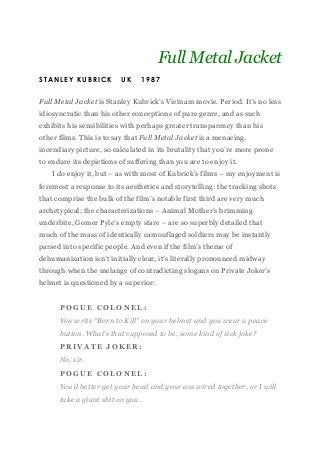
Duality of man
- 1. Full Metal Jacket STANLEY KUBRICK UK 1987 Full Metal Jacket is Stanley Kubrick’s Vietnam movie. Period. It’s no less idiosyncratic than his other conceptions of pure genre, and as such exhibits his sensibilities with perhaps greater transparency than his other films. This is to say that Full Metal Jacket is a menacing, incendiary picture, so calculated in its brutality that you’re more prone to endure its depictions of suffering than you are to enjoy it. I do enjoy it, but – as with most of Kubrick’s films – my enjoyment is foremost a response to its aesthetics and storytelling: the tracking shots that comprise the bulk of the film’s notable first third are very much archetypical; the characterizations – Animal Mother’s brimming underbite, Gomer Pyle’s empty stare – are so superbly detailed that much of the mass of identically camouflaged soldiers may be instantly parsed into specific people. And even if the film’s theme of dehumanization isn’t initially clear, it’s literally pronounced midway through when the melange of contradicting slogans on Private Joker’s helmet is questioned by a superior: POGUE COLONEL: You write “Born to Kill” on your helmet and you wear a peace button. What’s that supposed to be, some kind of sick joke? PRIVATE JOKER: No, sir. POGUE COLONEL: You’d better get your head and your ass wired together, or I will take a giant shit on you.
- 2. PRIVATE JOKER: Yes, sir. POGUE COLONEL: Now answer my question or you’ll be standing tall before the man. PRIVATE JOKER: I think I was trying to suggest something about the duality of man, sir. POGUE COLONEL: The what? PRIVATE JOKER: The duality of man. The Jungian thing, sir. This – the duality of man, or rather how ostensibly good men are reconditioned into injudicious killers – is only what the film says it’s about. The film’s opening – a montage of buzz cuts, culminating in a floor full of hair – succinctly prefaces this idea, and it’s redundantly hammered on by the drill instructor’s relentless string of profanities. Within minutes he reduces a roomful of men into identical maggots, faggots, or some other affront in his infinite barrage of depreciatory titles. But Full Metal Jacket is no more about the duality of man than it is about photography or set design or the economic considerations made by a colonel as he risks moving his fleet across dangerous terrain. It’s unlike Kubrick’s other films, which are as distinguished by their iconography – Alex’s monocle of eyelashes, Jack Torrance’s maniacal smile – as they are for their surfeit of Kubrickian hallmarks. Full Metal Jacket’s icons are less imperative, or at least they’re devalued by other war movies strewn in camouflage, blankets of ammunition, and destroyed urban locations.
- 3. Kubrick distills all the camouflage and chaos into concentrated cinematic moments, and the film has many noteworthy ones. In particular, late in the film Animal Mother – the most muscled and aggressive soldier – charges toward an unseen sniper, rushing past urban decay and flash fires. He’s armed with a machine gun nearly as long as he is tall, and strewn in belts of enormous bullets. This is as pornographic an image as any war movie could possibly possess. It’s also as emotionally artificial as a videogame on the same topic. It’s here that the irony of Kubrick’s penultimate film is made explicit. The idea is how soldiers must be dehumanized into killers, and how the casualty of this dehumanization is not the enemy, but the soldiers themselves—they become killers at the expense of their own innate compassion. But regardless of what’s determining the emotional core of any scene, the film remains so rapaciously visual that its central message is obscured. We are to consider how these men are emotionally and spiritually suppressed, yet we are also excited by their endeavor to obliterate the enemy. Given the outcome of the film’s final third, in which a remarkably skilled sniper is revealed to be a beautiful, seemingly defenseless young woman, I suspect that this irony may have been a deliberate manipulation on Kubrick’s part. This revelation elicits guilt because it is at this moment that the viewer comprehends the extent of a soldier’s compromise. Nonetheless, the film’s ideas progress on a level that isn’t precisely parallel to its aesthetics. It is possible to view this final scene and feel the same troubling hesitance that Private Joker does, as he aims his pistol at the fatally injured sniper. It is also likely that this hesitance was just preceded by an anticipatory excitement as Joker and his colleagues engage in a suspenseful tactical penetration of the sniper’s hideout. In the final scene, Joker (who’s been narrating the film intermittently) professes that he remains “in a world of shit,” recalling
- 4. Gomer Pyle’s admission just prior to his suicide in the opening segment. This disables any sense of accomplishment or resolution. In these moments the irony at the heart of the film reaches an apex: these are soldiers fighting a war they do not comprehend the purpose of, and the ones that survive return home compromised. “But I am alive,” continues Joker, “and I am not afraid.” The final image finds a mass of identical, anonymous silhouettes against a hellish, fiery background, marching forward, deprived of any clear destination.
